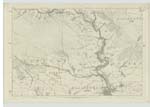OS1/25/42/11
| List of names as written | Various modes of spelling | Authorities for spelling | Situation | Description remarks |
|---|---|---|---|---|
| Supposed Site of the BATTLE OF MONS GRAMPIUS (Continued) | 052 | [continued from page 10] between Galgacus & Agricola, it is highly probable that the scene will never be precisely ascertained. Our only information on that subject, is derived from Tacitus who, though he gives us a most animated description of the engagement itself, leaves us very much in the dark as to the scene of it. From him we learn only, that it must be somewhere at the foot of Mons Grampius; but every one knows that the Grampian Mountains traverse the whole extent of Scotland, from the vicinity of Aberdeen to Cowal in Argyllshire. In this extensive range, there have been four different places, & these considerably distant from one another, supposed to be each of them the field of this battle. - The first of these is at Fortingale, at the foot of Glenlyon, in the very centre of the Grampians, where the vestiges of a Camp, apparently Roman, are still visible &c &c. The second spot is at Comrie, near the head of Strathern, where there is likewise the appearance of a Roman Camp, & where the scene, indeed is less circumscribed than the former; but here also objections occur &c &c. The third place alleged to be the scene of the battle, is near Fettercairn, in the county of the Mearns &c. We do not find in the Mearns any piece of Antiquity so likely to have been a station for the Roman legions, as the long vallum at Meiklour. But there seems to be our insuperable objection to the scene in the Mearns: Tacitus expressly tells us, that, immediately after the engagement Agricola marched off his army into the country of the Horesti; & as the Horesti were the inhabitants of Angus and Mearns it is not at all probable that such an accurate historian as Tacitus would have used such an expression, if the battle had been fought anywhere within the limits of their country. - The last spot presumed to have been the scene of this Engagement, is the Heer Cairns, with the grounds in their neighbourhood. This on an attentive investigation, appears to be at least as probable a scene as any of the four. Agricola could not, perhaps, in all Strathmore, have pitched upon a more favorable station for his legions than that elevated plain comprehended between the Cleven dike & the confluence of the Tay and the Isla. It is at no great distance from the mouth of the Tay, where the Roman Army, in case of defeat might have had a more easy access to their ships. On the W. [West] it is defended by the steep bank of the Tay, on th S.E. [South East] & N.E. [North East] by the banks of the Isla & the Lunan. It commands a distinct view of the higher grounds of the Stormont, to the N. [North] & N.W. [North West] it looks directly westward on the entrance into the Highlands, by Dunkeld, which was then the capital of the Caeldonians & in the vicinity of which we may suppose it would be natural for them to hold their general rendezvous on this occasion. This supposed station of the Romans is about 3 or 4 miles S.S.E. [South South East] from that of the Caledonians at the Buzzard Dikes. In several parts of this neighborhood, the surface of the ground exhibits a singular appearance of long hilly ridges (or (or drums answering very well to the "Colles" of Tacitus). This appearance is remarkably exemplified at the Guard Drums, which are partly inclosed by the Buzzard Dike or Vallum which is still in many places 8 or 10 ft [feet] high. This inclosure through which the burn of Lornty passes, might be designed by the Caledonians principally as a place of security for their cattle and provisions, as well as for their wives and children. These "Colles" or long extended eminences, rising gradually one above another, were well fitted for displaying the Caledonian Army to the best advantage. Mr. Playfair is of opinion, that the two armies might have met, and the line of battle might have been formed, somewhere on the lower grounds of Bullerd or Balcairn. If so then Agricola's right wing might extend to the neighborhood of that hill (above Marlei) which still retains the name of Craig [continued on page 12] |
Continued entries/extra info
[Page] 11[Notes in left hand margin beside relevant parts of description:]
"Haer Cairns" on 52-9 Kinloch Ph. [Parish]
"Cleaven Dike" on 63-11 & 15 Caputh Ph. [Parish]
(Roman Camp)
"Buzzart Dikes" on 52-9 Kinloch Ph. [Parish]
(Caledonian Camp)
"Garry Drums" on 52-9 Kinloch Ph. [Parish]
Transcribers who have contributed to this page.
Alison James- Moderator, Brenda Pollock
Location information for this page.
Linked mapsheets.




